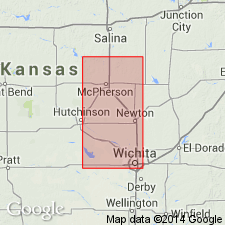
- Usage in publication:
-
- Delmore formation*
- Modifications:
-
- Original reference
- Dominant lithology:
-
- Silt
- Clay
- Sand
- AAPG geologic province:
-
- Sedgwick basin
Summary:
Pg. 56-59, pl. 1. Delmore formation. Proposed for Pliocene sediments underlying area north and northwest of Canton and Galva, Delmore Township, McPherson County; beds were originally assigned to Emma Creek formation, type beds of which were considered to be Pliocene; on the basis of present study, beds at type locality of Emma Creek are assigned to Pleistocene and Emma Creek abandoned; the Delmore does not extend into type area selected for Emma Creek. formation consists of calcareous gray to buff silt and clay, fine- to coarse-grained sand, and some gravel; locally the calcium carbonate has been concentrated and forms irregularly shaped nodules and thin layers within the silt. Maximum thickness about 75 feet as shown by test drilling. Underlies McPherson formation. Age is middle Pliocene.
Type area: in secs. 24, 25, and 26, T. 18 S., R. 2 W., and along ravines in sec. 31, T. 18 S., R. 1 W., McPherson Co., central KS.
Source: US geologic names lexicon (USGS Bull. 1200, p. 1082-1083).
For more information, please contact Nancy Stamm, Geologic Names Committee Secretary.
Asterisk (*) indicates published by U.S. Geological Survey authors.
"No current usage" (†) implies that a name has been abandoned or has fallen into disuse. Former usage and, if known, replacement name given in parentheses ( ).
Slash (/) indicates name conflicts with nomenclatural guidelines (CSN, 1933; ACSN, 1961, 1970; NACSN, 1983, 2005, 2021). May be explained within brackets ([ ]).

